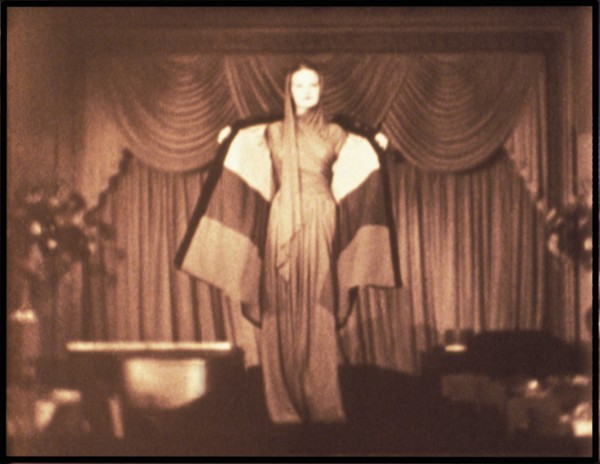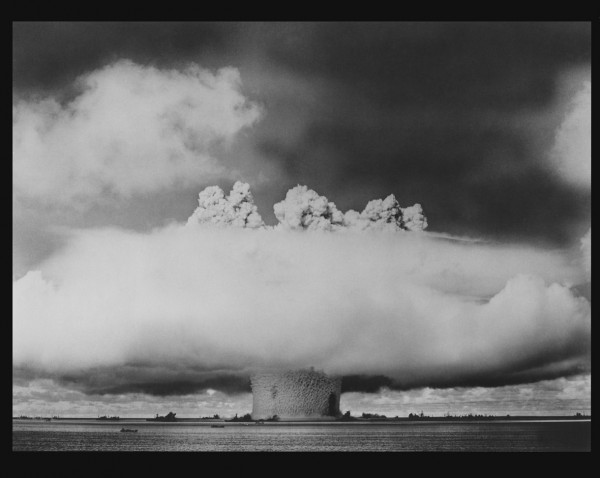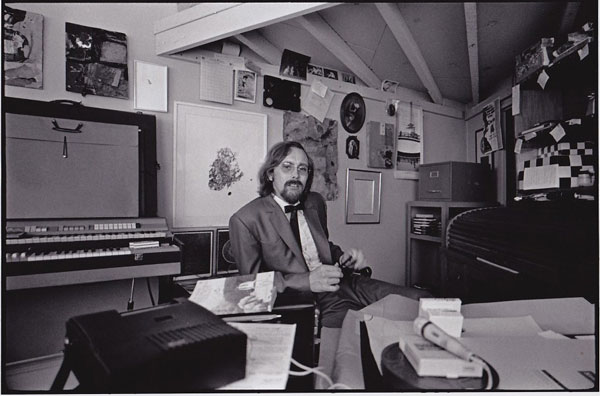-
Frankenstein’s Anti-Pop, Cultish Social Form: Bruce Conner at Film Forum
by Stephanie Harris November 11, 2010

The language of the visual world is both internal and external, simultaneously ignored and unconsciously absorbed. In rare instances its manipulation enables us to perceive it and to take part in the conversation. The mind works incessantly, constantly consuming images, with little respite to meditate on the well of rapidly accruing connotations. On those occasions when the vocabulary is revealed, we can consider how these associations relate to one another and delineate our perception; an almost spiritual introspection of our visual databank and an opening for active participation in the visual dialogue.
When Bruce Conner passed away in 2008 at the age of 74, his legacy, like his work, was not a simple one to decipher. His was a multifaceted career piloted by an ardent skepticism. Where he mistrusted words, he worked with images. When his style was commended, he changed it. When the commercial art world accepted him, he faked his death (his first solo show was titled, “The Work of the Late Bruce Conner”). He was dubious of institutions, terminated his career more than once, withdrew his films from distribution and often sent proxies to play ‘Bruce Conner’ at panels or screenings. When it came time to memorialize the protean Conner, he was canonized for his work in sculpture, collage and assemblage, but it was his experimentation with the moving image that won him overwhelming tribute and lingers as his most relevant work.
Conner first garnered attention for his assemblages in the late-1950s. The mysterious clusters of forgotten material (wood scrap, torn nylons and trashy magazines were signatures) thrived on a tension between the distinct and the entire. Hidden symbols or objects, perhaps enmeshed by nylon or encased in wax, kept works alive by tempting viewers to scrutinize their surface. The hidden is both obstructed, yet imbued with the energetic compulsion to be revealed.

Eventually, Conner grew apathetic of amassing praise for his assemblage work and returned to an early love of cinema. In 1958, friend and filmmaker Larry Jordan taught Conner how to splice film. Unable to afford a camera or film stock, he salvaged several hundred feet of “used” newsreel, instructional film, commercial stock and narrative features at a photography shop. What came of those reels thrust him deeper into the art-world limelight and made a lasting impact on American experimental film.
Throughout Conner’s childhood he digested the vocabulary of popular cinema at the McPherson, Kansas movie theater, fashioning a lexicon he carried into adulthood. What most interested him, then and later, were the structures and devices unconsciously received by audiences. From an early age Conner recognized in the methodical editing, recycled footage and repetitive narratives a persistent structure of feature films. Seduced by this secret dialogue across seemingly distinct works, Conner made it the focus of his own.
A Movie, from 1958, was Conner’s first film and an attempt to create the “anti-movie.” In 12 minutes of images and sound he finds enigmas, impetus and consequence, summoning the structure of conventional film making to the foreground and challenging the accepted method of reception. The initial swell of a cinematic soundtrack engenders our expectations, but is accompanied by 30-seconds of the static title ‘Bruce Conner’. Two minutes in, Conner has already demarcated the elements of narrative cinema by rearranging title sequences, countdown leader and end credits interspersed with footage of a sexy strip tease. The remainder of the film is a series of hilarious, bizarre and often horrific visual puns and juxtapositions. Nude women, explosions, war footage, dare devils, plane crashes and Hollywood chase scenes are woven in a swift, kinetic cadence and set to a dramatic soundtrack. The most obvious Hollywood tropes are present but arranged to expose their edges; they appear arbitrary here to highlight the intention behind their arrival everywhere else.

While not the first to use found-footage, Conner’s total commitment to it was new, and the results were in many ways more potent than anything previously seen. Following the energetic rhythms of A Movie, Conner continued making films from his growing library of found images. In 1967 he completed his seventh film, Report, concerning the media representation of the JFK assassination. The film first illustrates, then critiques, the overabundance of coverage and the collective obsession with following it. Walter Cronkite’s famous report guides the audience as we are escorted through the events of November 3, 1963 via repetition of the assassination footage, flickering screens, television advertisements, bull fights and movie clips from Frankenstein. If the media-as- Frankenstein’s-Monster conceit feels a bit dated it is only because it has become one of the organizing principles of contemporary production, endlessly translated, compulsively reiterated. It is a credit to Conner that he can thus be read as a Frankenstein of our own, as his pop-cultural assemblage, animated and baleful, continues to stalk the realm; an undead form persisting past the point of critical efficacy.
Released during the long ascent of Pop Art, Conner’s films offered an alternative vision of the visual commodity and image culture. As opposed to the bright, tonic imagery characteristic of the genre, Conner drew from the decayed and cheerless, relying on the insignificance of his acquired reels. His films seem stained by history, implying a darker ‘anti-pop’. He once elaborated, “I get impassioned and that’s not cool and cool was what pop art was all about.”
Conner’s early, fast-paced films are set off by their refusal to let audiences see through the screen. In laying bare the tropes of orthodox film making, he reminds us of the film’s physicality, rooting viewers in their seats. Uprooted images and empty screens make typical, unconscious absorption impossible. Viewing these films today begs the question of what a similarly materialist ruthlessness would look like for our own time. Not only is film itself no longer physical in the same way, but its not clear that the same sort of passive image-ingestion is at work in the digital age; we are instead presented with new structures, new products. To watch Conner’s early work is to feel a twinge of melancholy; a longing not only for his uncompromising clarity, but for its availability as a position.

By the 1970s, other filmmakers had began working in Conner’s style and he lost interest, pursuing a radically different approach in three of his most famous works, Crossroads, Valse Triste and Take the 5:10 to Dreamland. These films, propelled by gentle, ambient soundtracks, abandoned the visually arresting, rapid-fire editing of his earlier works. Crossroads is a 36-minute montage of slowly shifting mushroom clouds cobbled from Defense Department footage of nuclear testing. Through 27 different takes of the tests, Conner edits a film of inharmonious emotions, creating a visual ode to an ultimately destructive power, tempting us with the beauty of its aftermath. Valse Triste and Take the 5:10 to Dreamland unveil a more meditative style. Simple and elusive in their nature, both invoke a dream-like state, providing a metaphor for reflective experience. Take the 5:10 to Dreamland weaves an ambiguously unstructured series of images, coincidental and meandering. While his early films highlighted the confines of the medium, 5:10 refuses it outright, denying the existence of a cinematic boundary. Valse Triste follows a similar pattern but with autobiographical undertones of a Kansas boyhood dream.
In 1978 Conner returned, in a way, to the spirit of his earlier interventions with Mongoloid, set to Devo’s song of the same name. Long before MTV, Conner produced a rhythmically and intellectually resonant relationship between music and the moving image. Mongoloid combines educational science videos, film clips and television advertisements to tell the story of a boy who conquers a mental disability to become a useful, even ideal, man. This film, along with his work for Brian Eno and David Byrne (Mea Culpa and America is Waiting) are the star witnesses in the case for Conner’s fathering of the music video. It is a vigorously contested paternity. Presented with the title, the artist, in a phrase doubly delightful for its reciprocal implications “demands a DNA test.”
![Conner_Jackie[0]](../../../wp-content/uploads/2010/11/Conner_Jackie0-e1289465023731.jpg)
Conner’s contributions to film are, in very real sense, undeniable. Since his early explorations, sampling and remixing have become mainstream, even traditional, in film and video. In unearthing a common cinematic and visual language, he charged the use of pre-existing and discarded imagery with an emotional and political power whose influence cannot be overstated. So long as repetition, saturation, and vapidity continue to characterize the lived experience of the moving image, the devastating simplicity of Conner’s deconstruction, de-contextualization and re-materialization will retain its urgency. No two viewings of a Conner film are the same, for as images relentlessly sediment the edges of our consciousness, his work persists in drawing our attention to the latest elsewhere of the everyday. New associations are made and new possibilities opened. Conner’s films are an enigmatic cancer of visual exchange, growing more vital with each encounter.
Still, his moment is not our own, and though this fact is often brandished to wish away the ghosts of didactics past, it is, itself, an opening. Just as coral reefs are so many skeletons, appearing only as a certain life departs, so too the form of art, its architecture, emerges only when its temporal surface turns to dust, burns off, and vanishes in the shifting wind. And so the audacity of Conner’s work takes place a second time, as it debuts its bones. That these are so familiar is to signal their significance, as evidence in the archive of our becoming.
In an interview with William C. Wees, Conner said, “I’ve always known that I was outside the main, mercantile stream. I have been placed in an environment that would have its name changed now and again: avant-garde film, experimental film, independent film etc. I have tried to create film work so that it is capable of communicating to people outside of a limited dialogue within an esoteric, avant-garde or a cultish social form. Jargon I don’t like.” Conner created a kaleidoscopic vision that interacts with any who agree to watch. A refreshing take on the sometimes cryptic genre of the ‘experimental’, his films are inviting, humorous, emotionally legible and dramatically charged. Literally written in a language everyone can understand, they can be superficially enjoyable or effectively inexhaustible. They offer as much as you want to take.
Film Forum presents: ‘Bruce Conner: The Art of Montage’, November 10-23


1 Comment
Weekend roundup | Tyler Green: Modern Art Notes | ARTINFO.com
[...] Idiom, Stephanie Harris previews a Bruce Conner film-fest at NYC’s Film Forum. « Friday links Blog Home Weekend [...]